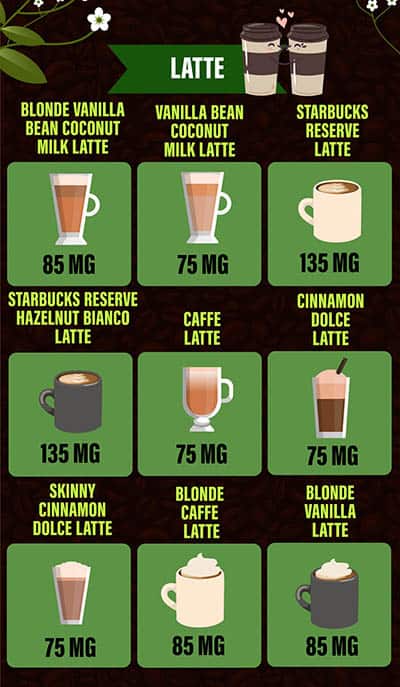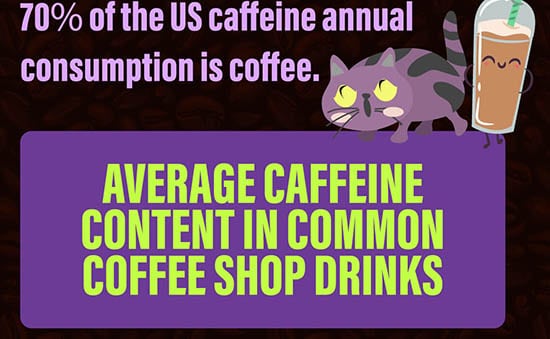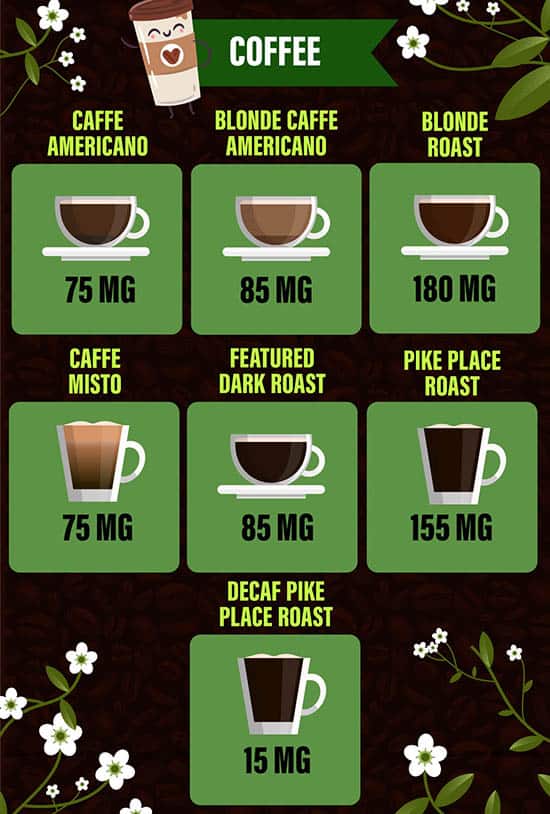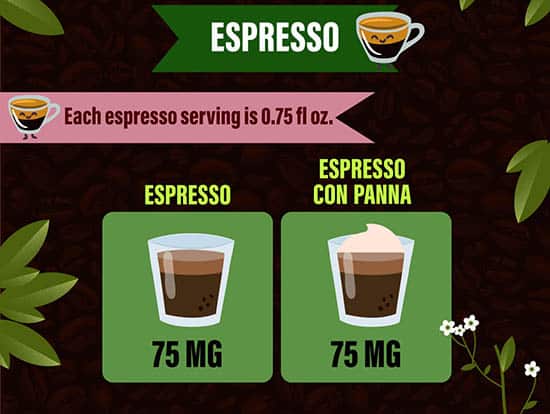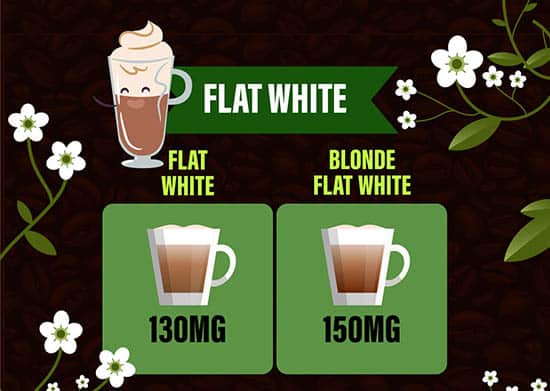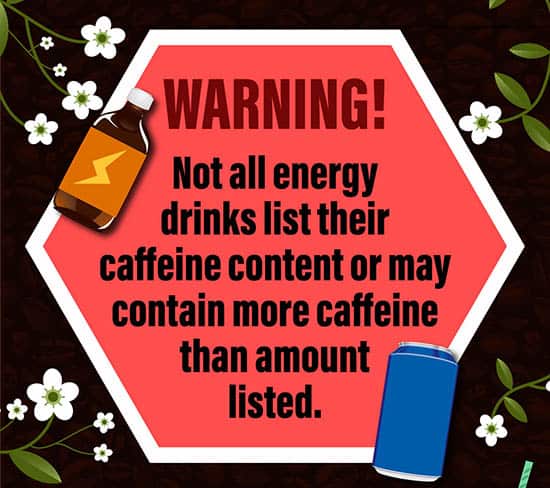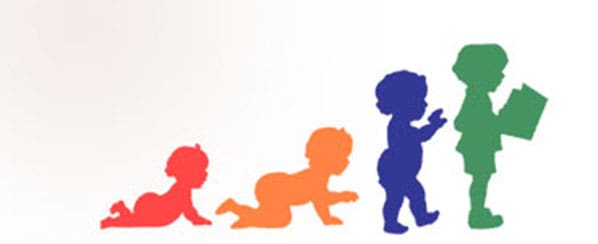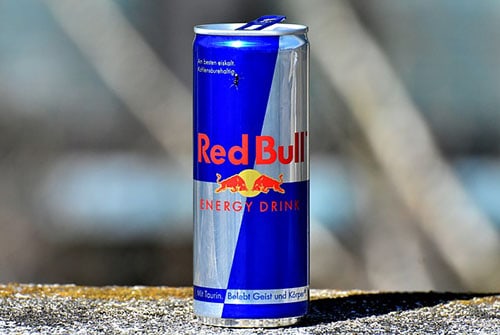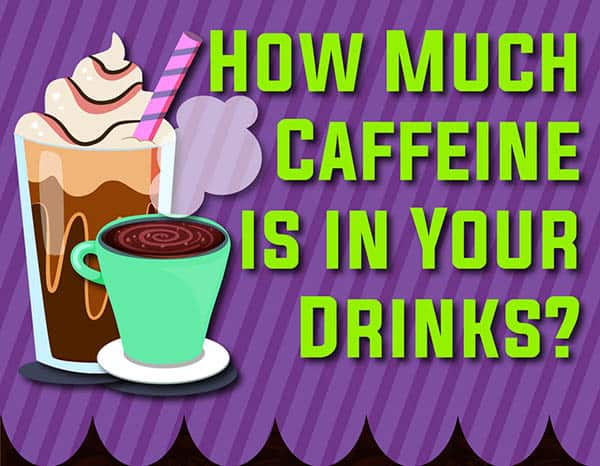
All of us have probably come across various social media and news article claiming that coffee is great for brain functioning and contains anti-aging properties. Many people may probably begin consuming more just because of these health facts. But what many have not consider is the amount of caffeine they are taking in each day. Here are 45 alarming statistics on Americans’ caffeine consumption habit:
American’s Caffeine Consumption Habit

- The introduction of Starbucks in 1995 created a 700% increase in coffee consumption between 1995 to 2000. (University of New Hampshire)
- The average consumption of caffeine was 120 mg per day in 1999. The number grew to 165 mg per day in 2010. In 2017, the average intake is 190 mg per day. (Statista)
- The Kantar Worldpanel Beverage Consumption Panel survey estimated that 85% of Americans over the age of 2 are consuming at least 1 caffeinated drink per day. At least 68 million Americans drink three cups of coffee every single day. (Kantar Worldpanel)
Some 30 million Americans drink five or more cups of coffee every single day.
3. Over 21 million Americans drink six or more cups of coffee every day. (Food and Chemical Toxicology “Beverage Caffeine Intakes in the US”) - Amongst all caffeine consumers, those between 50 to 64 age group tend to take in the highest amount of caffeine. (Statista)
- The top 10% highest amount consumers take in an average of 380 mg per day. (Critical Reviews in Food Science and Nutrition “Caffeine Intake and Its Sources: A Review of National Representative Studies”)
- Although coffee takes the 1st place in beverage choice among all age groups, individuals younger than 18 years of age tend to prefer soft drinks and tea as their first choice of caffeinated beverage. (Food and Chemical Toxicology “Beverage Caffeine Intakes in the US”)
- Americans are steadily consuming more caffeine each year from 23.81 million 60-kilogram bags of coffee in 2013 to 25.84 million 60-kilgrams bags of coffee in 2017. (Statista)
- According to the consumer report surveys, the number 1 reason why Americans drink coffee is that they simply like the taste. Here is a breakdown of other reasons why participants drink coffee:
| Rank | Reason | Number of Participants Agree with This Reason |
| 1 | I like the taste | 62% |
| 2 | To wake me up | 58% |
| 3 | For pleasure | 46% |
| 4 | To warm myself up | 36% |
| 5 | It makes me happy | 33% |
| 6 | To relax | 29% |
| 7 | Out of habit | 28% |
| 8 | To try new flavors | 14% |
| 9 | When in company | 12% |
| 10 | After a meal or for digestion | 9% |
- 68% of coffee consumer reported that they usually drink their first cup of coffee within 1 hour after they arise from bed. (HealthResearchFunding)
I recommend reading the following articles as well:
Caffeine in Products on Market
- United States is not even in the top 10 countries that consume the most coffee:
| Rank | Country | Coffee Consumed Per Person Per Year |
| 1 | Finland | 12.0 Kg |
| 2 | Norway | 9.9 Kg |
| 3 | Iceland | 9.0 Kg |
| 4 | Denmark | 8.7 Kg |
| 5 | Netherlands | 8.4 Kg |
| 6 | Sweden | 8.2 Kg |
| 7 | Switzerland | 7.9 Kg |
| 8 | Belgium | 6.8 Kg |
| 9 | Luxembourg | 6.5 Kg |
| 10 | Canada | 6.5 Kg |
| 25 | United States | 4.2 Kg |
- 96% of beverage caffeine is consumed from coffee, soft drinks, and tea. Out of all caffeinated beverage choices, 70% of the US caffeine annual consumption is coffee. (Food and Chemical Toxicology)
- Here is the list of the top 20 drinks available on market that contains the highest amount of caffeine:
| Rank | Drink | Fl oz | Caffeine Content (mg) |
| 1 | Cannonball Coffee | 12 | 1101 |
| 2 | Biohazard Coffee | 12 | 928 |
| 3 | Coffee Crave Fearless Black | 12 | 844 |
| 4 | Bizzy Cold Brew | 16 | 750 |
| 5 | Death Wish Coffee | 12 | 728 |
| 6 | Black Insomnia Coffee | 12 | 702 |
| 7 | Starbucks Classics Café Mocha | 48 | 510 |
| 8 | ALRI Hypershot | 2 | 500 |
| 9 | Liquid Caffeine | 1 | 500 |
| 10 | Killer Coffee | 8.46 | 430 |
| 11 | 10-Hour Energy Shot | 1.93 | 422 |
| 12 | Death Wish Nitro Brew | 11 | 381 |
| 13 | Rage Inferno | 24 | 375 |
| 14 | Redline Power Rush | 2.5 | 350 |
| 15 | Spike Energy Double Shot | 4.26 | 350 |
| 16 | Spike Energy Drink | 16 | 350 |
| 17 | Stumptown Cold Brew Chocolate and Milk | 16 | 340 |
| 18 | Starbucks Grande Coffee | 16 | 330 |
| 19 | Starbucks Nitro Cold Brew | 16 | 325 |
| 20 | BANG Energy Drink | 16 | 300 |
- Survey studies found that over 60 million Americans have problem falling asleep at night. Moreover, as much as 30% of children are suffering from the same problem. One major contribution to this problem is hidden caffeine in many food items. (NPR)
- Here is a list of hidden caffeine found in common foods and over-the-counter medication:
| Food | Hidden Caffeine Amount |
| Energy Water | 50 to 125 mg per bottle |
| Chocolate | 31 mg per serving |
| Ice cream and Frozen Yogurt | 30 mg per serving |
| Cacao Nibs | 22 mg per serving |
| Protein Bar | 14.5 mg per serving |
| Decaffeinated Coffee | 12 mg per serving |
| Cereal | 11 mg per serving |
| Candy Bar | 10 mg per serving |
| Hot Chocolate | 9 mg per serving |
| Chocolate Milk | 5 mg per serving |
| Pudding | 4 mg per serving |
| Decaf Tea | 2 mg per serving |
| Over-The-Counter Medication | Hidden Caffeine Amount |
| Pain Relief Medication | 130 mg per dose |
| PMS Medication | 60 mg per dose |
| Weight Loss Pills | 1,223 mg per daily dose |
Side Effects of Caffeine Over-Consumption
- The US FDA recommends that adults should limit their caffeine intake to no more than 400 mg per day. (FDA) Yet for individuals in certain occupations that require working in shifts such as police officer, firefighters, army personnel, and medical staffs, they can consume up to 1000 mg of caffeine per day.
- It has been reported that consumption of 10 g or more caffeine can cause acute condition in which the individual will experience seizure and severe vomiting. However, depending on a person’s body weight, the symptoms may be more or less severe. Studies have shown that as little as 1 g of caffeine can already produce neuromuscular tremors, delirium, seizure, and abnormal increase in heart rate. (Goodman and Gilamn’s The Pharmacological bases of Therapeutics in Two Volumes) A 10-Hour Energy Shot already contains 422 mg of caffeine in one vial. A 48 oz. Starbucks Classics Café Mocha consists of 510 mg of caffeine. Just 2 of these drinks can already trigger fatal side effects.
- The American Psychiatric Association cited that 1,000 mg or more of caffeine intake can cause symptoms similar to anxiety disorder and even psychosis symptoms. However, clinical studies have shown that some people are less tolerant of caffeine depending on their genetic background. (Advances in Psychiatric Treatment “Neuropsychiatric Effects of Caffeine”)
- Experiment research has shown that just by taking in 300 mg of caffeine can double an individual’s perception of stress. (Psychpharmacology “Anxiety Sensitivity and Expectation of Arousal Differentially Affect the Respiratory Response to Caffeine”)
- Studies indicate that the amount of caffeine intake is correlated to the quality of sleep. Participants reported poor sleep when they consumed 192 mg of caffeine, whereas others reported much better quality sleep when they drank less (125 mg). (Nutrients “Caffeine Consumption and Sleep Quality in Australian Adults”)
- Experiments have shown that the caffeine chemical can stay in the human body for an average of 5 hours. However, the elimination process can range between 1.5 to 9.5 hours depending on the person’s health, metabolism rate, and other conditions such as body fat ratio, smoking habit, and even altitude. (Caffeine for the Sustainment of Mental Task Performance: Formulations for Military Operations)
- Consuming more than 744 mg of caffeine can significantly increase the loss of magnesium and calcium by urination. (J Am Coll Nutri “Effect of Caffeine on Circadian Excretion of Urinary Calcium and Magnesium”)
- Longitudinal studies suggests that drinking at least a cup of coffee per day can decrease the risk of developing type 2 diabetes by 11%. Those who decrease coffee intake by 1 cup were shown to increase their risk by 17%. (Healthline) However, women who have a history of low bone-density, osteoporosis, and arthritis should be aware of the calcium and magnesium reduction side effects as it could increase the severity of these health issues.
- Clinical studies have found that men who drink more than 32 oz. of coffee per day have a 21% increase risk of early death. (NBC)
- Young adults who have a history of hypertension and consume more than 32 oz. of coffee a day have 3 times the risk of suffering from a heart attack. (EurekAlert!)
- Women who consume 31 to 250 mg of caffeine per day have 1.5 greater risk of developing fibrocystic breast disease. Those who drink more than 500 mg per day have a 2.3 increased risk. In general, caffeine causes hormone changes and increases the likelihood of an individual to develop cysts. (Oxford Academic)
- Although how exactly caffeine decreases female fertility is unknown, the theory suggests that caffeine causes hormone changes in the female body and reduces fallopian tube muscles from carrying eggs to the womb. In addition, men who consume more than 265 mg of caffeine per day are shown to have lower sperm counts and lower chance of fertilizing an egg via IVF method. (Medical Press)
Caffeine and Children Development
- As of 2014, about 73% of American children were drinking caffeinated beverages on a daily basis. (CNN)
- Another study in 2015 found that toddlers as young as 1 year of age were already drinking coffee. The survey study stated that 2.5% of 1-year-old was consuming coffee, and 15% of 2-year-old was consuming coffee. These toddlers were drinking a maximum of 4 ounces of caffeine per day. (US News)
- The U.S. FDA recommends that children between ages 6 to 12 should limit their caffeine consumption to 45-85 mg/day, and children over the age of 12 should limit their caffeine intake to 2.5mg/kg per day. (FDA)
- 2% of teenagers admitted to consuming caffeine on a daily basis, and 96% stated that they consume caffeine sometimes. 9 out of 10 high school adolescents report that they have problem with sleeping because of the amount of caffeine the take in throughout the day. (Medical News Today)
- 78% college freshmen students reported consuming 3 to 5 times more than 400mg of caffeine per day. (American Journal of Health Education)
- Clinical experiment studies have found that low doses of caffeine (3 mg/kg of weight) tend to decrease heart rates while elevate blood pressure in all children. Higher doses of caffeine tend to both speed up heart rate as well as increase blood pressure. (Pediatrics “Cardiovascular Responses to Caffeine by Gender and Pubertal Stage”)
- Caffeine is a stimulant. Studies have shown that a 500 mg dose of caffeine can have the same effect on the human body as a small dose of amphetamine. (Sleep Education)
- Researchers have found that children who suffer from major depressive disorder tend to decrease their symptoms by as much as 4 times when they consume caffeine. However, the consumption can induce anxiety symptoms and problem with sleeping. (Pediatric Pscyhology)
- Teenagers who consume an average of 1 energy drink a day self-reported more problems with behavior regulation and metacognition. Those who consume more than 2 cups a day also reported about metacognition difficulty. (Frontiers in Psychology)
- A development survey study found that teenagers who drink at least 2 serving of caffeine on a daily basis exhibit less sleep time and lower quality of deep sleep than those who consume less or do not consume caffeine at all. As deep sleep is linked to cell recovery and neural network development process, this finding suggested that high amount of caffeine consumption can disrupt adolescent development. (Brain Science “Caffeine Consuming Children and Adolescents Show Altered Sleep Behavior and Deep Sleep)
Dangers of Energy Drinks
- In a consumer study, 11 of 27 energy drink brands do not state the specific amount of caffeine on their labels due to the reason that there is no legal requirement enforcement on this business practice. 5 of them were found to contain 20% more caffeine than the listed label. (Consumer Reports)
- National self-report surveys indicate that 30 to 50% teenagers across the United States are consuming energy drinks. On average, each serving of energy drink consists of about 74 mg of caffeine. Here is a top 20 list of highest caffeine content energy drink brands on market:
| Rank | Brand | Fl oz. | Caffeine (mg) |
| 1 | Rage Inferno | 24 | 375 |
| 2 | Spike Energy Drink | 16 | 350 |
| 3 | Wired X344 Energy Drink | 16 | 344 |
| 4 | Stuptown Nitro Cold Brew | 11 | 330 |
| 5 | Redline Xtreme Energy Drink | 8 | 316 |
| 6 | BANG Energy Drink | 16 | 300 |
| 7 | Celsius Heat Energy Drink | 16 | 300 |
| 8 | Ripped Hardcore Liquid Energy Drink | 11.16 | 300 |
| 9 | SPIKE Shooter | 8.4 | 300 |
| 10 | Viso Energy Drink | 20 | 300 |
| 11 | Cocaine Energy Drink | 8.4 | 280 |
| 12 | Outlaw Energy Drink | 16 | 250 |
| 13 | Potencia Energy Drink | 16 | 250 |
| 14 | Fuel Energy Drink | 16 | 240 |
| 15 | Mega Monster Energy Drink | 24 | 240 |
| 16 | Rockstar Iced Energy Drink | 16 | 240 |
| 17 | Rockstar Perfect Berry | 16 | 240 |
| 18 | Rockstar Punched | 16 | 240 |
| 19 | Rockstar Pure Zero Energy Drink | 16 | 240 |
| 20 | Spider Energy Drink | 16 | 240 |
- 6% of children between the ages of 12 to 24 admitted to consuming energy drinks on a regular basis.
- In 2015, 2062 emergency calls were involved children under 6 years of age exhibiting major side effects after consuming energy drinks. (CNN)
- Cross-sectional survey studies on American adolescents between ages 12 to 18 who reported daily consumption of energy drinks came up with 4 common health symptoms:
- Headache
- Problem with sleeping
- High irritability
- Constant fatigue
- It is estimated 15% of American adolescents between ages 13 to 19 are mixing energy drinks with alcohol, and 9% are mixing the drinks with illegal drugs. Approximately 40% stated that they experienced adverse symptoms after consuming energy drinks. (Science Daily)
- In 2007, 2506 energy drink related death cases occurred to individuals younger than the age of 19. (Pediatrics)
- Guarana is a common ingredient in energy drinks. Known as Brazilian cocoa, it contains high amount of caffeine (explains for the hidden unreported caffeine source). It is known to cause glaucoma effect in some individuals and low blood glucose level in type 1 diabetes individuals. Clinical studies have shown that taking in more than 200 mg of guarana can significantly increase the risk of miscarriage, irregular rapid heart rate, elevated blood pressure, delirium, and cardiovascular problems. (WebMD)
- Scientific health researchers confirm that just by consuming 1 energy drink on a daily basis can increase stress hormone level by 74% and increase the blood pressure by 6.4%. For people who have a family history and/or underlying heart condition, 2 cans of energy drink a day can increase the risk of cardiac arrest by 20%. (Independent)
Further reading:
Even though coffee and energy drinks contain properties that claim to be valuable to our health, over-consumption of caffeine can actually create side effects and health problems that overshadow the benefits. What is even more important is that parents should pay closer attention to hidden caffeine in pre-packaged foods. Although hidden caffeine amounts may be relatively small, they can add up to a substantial amount that surpasses the FDA safety level for children and teenagers. This accumulation can also be the culprit in an adult’s late night tossing and turning in bed. For those who are suffering sleeping problem, this can be an issue worth tackling.


